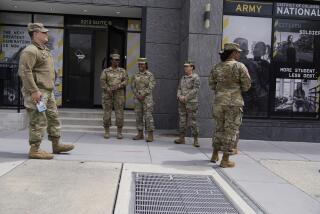NEWS ANALYSIS : Smaller War Chest May Box In U.S. Military
- Share via
WASHINGTON — The Clinton Administration is rapidly approaching a major crossroads in the battle over its defense strategy: whether to abandon its plan to cut the size of the armed services still further or risk damaging military preparedness at a time when it is frequently resorting to military intervention in hot spots around the globe.
Even as the military budget and the size of the armed forces have declined sharply, the number of missions on which U.S. troops are being sent has been soaring--Haiti, Cuba, Rwanda and the Persian Gulf in the last year alone, and now possibly Bosnia and the Golan Heights.
Some parts of the military plainly have been stretched thin--with sometimes disastrous results, such as the mistaken downing of two Army helicopters by U.S. F-15s over Iraq in April.
There are pockets in each service where military preparedness has begun to slip. All the services began running short of money just before the end of the fiscal year. Navy pilots suddenly saw their training flights halved. Army units had to cancel key practice maneuvers. Maintenance schedules were cut back.
Administration fiscal strategists had always known that downsizing the military would prove a bumpy process. But they had hoped to avoid any really serious crunch through an intricate juggling of some major elements of the defense budget.
Over the long run, they plan to boost the effectiveness of the nation’s rapidly shrinking fighting force by supplying it with more sophisticated weapons, such as laser-guided bombs, and equipping it to deploy far more quickly.
That ultimately would require added spending. But defense planners had hoped to get around that by temporarily cutting back on big weapon programs until the Pentagon could capitalize on projected savings from base closings and reform of the purchasing system.
The problem is that those savings are proving more elusive than the Administration had expected, and the President’s propensity to deploy troops is driving up the military’s operating costs.
Although the United States will get back from its allies part of the money that the Pentagon has spent on international peacekeeping, much of it will be siphoned from the services’ day-to-day operating budgets, crimping training and threatening military preparedness.
The Administration also has been hit with the added cost of a congressionally mandated military pay raise that the Pentagon had doggedly omitted from any of its previous long-term budget planning.
What all this adds up to is a gap of $40 billion to $140 billion between what the military says it needs in the next five years and what it expects to have on hand under current budget projections.
While the lower end of the range--an average of $8 billion a year in budget cuts--may seem modest in an annual Pentagon budget of $260 billion, defense experts say it is magnified by the combination of previous years’ budget cuts and mounting demands on the military.
As a result, many analysts say they believe that Clinton will be forced to decide this year whether to provide more defense money to finance the armed forces properly or sharply restrict the number of times that he sends troops abroad.
“It’s clear that the force that (Clinton) has designed is no longer affordable without some sort of major mid-course correction,” said Don M. Snider, a former Pentagon planner now with the Center for Strategic and International Studies, a centrist defense-monitoring group. “. . . Either he’s going to have to use the military less or he’s going to have to generate more savings--by closing a lot more bases.”
Andrew F. Krepinevich, director of the Defense Budget Project, a nonpartisan defense-monitoring group, foresees tough choices for Clinton. “Ultimately, he may have to decide whether to cut domestic programs or raise taxes,” Krepinevich said.
Military preparedness is a special concern. Retired Gen. Edward C. Meyer, Army chief of staff in the early 1970s, warned that readiness “does not decline gracefully” under the influence of budget cuts.
Rather, he said, preparedness worsens gradually and then plummets. When that happened 20 years ago, he called the result the “hollow forces”--a large military that wasn’t very effective.
Clinton’s activist foreign policy has heightened the risk. Because combat troops are on the go more than they were during the Cold War, the military’s tanks, planes and ships require much more maintenance--and will need earlier replacement.
The “operating tempo,” as the military calls it, is also straining military personnel and their families. Soldiers and Marines returning from duty in Somalia were abruptly sent off to Haiti.
There are already some signs that the strains are taking a toll. New surveys show a decided decline in re-enlistment.
More than that, Pentagon planners worry that the perpetual high-gear pace in some military units may be affecting performance. The air controllers involved in the helicopter downing over Iraq, for example, had been deployed away from home far longer than usual.
Clinton has pledged to “hold the line” on military cuts beyond those he has already proposed.
“There is a limit to how much we cut our national defense and still protect the security of America and the vital interests of America, and I tell you that I think we have reached that limit,” he told a business group. “We have cut defense all we can.”
But the President’s budget already calls for a full 10% decline in defense spending during the next two years, after inflation.
The Defense Department’s civilian leaders, straining for ways to cut spending in fiscal 1996, ironically are beginning their cuts with the same weapon development programs that they had hoped would help the military keep its edge in the late 1990s.
In a memo in August, Deputy Defense Secretary John M. Deutch ordered the services to submit plans for possible delay or even cancellation of 10 big development programs, including the Air Force’s F-22 advanced fighter and the Navy’s new attack submarine.
Defense Secretary William J. Perry has vowed to protect readiness and such quality-of-life issues as the number of days that service personnel must spend on overseas deployment each year.
But some military analysts say they fear that cutting research, weapon programs and training now will only risk eroding military preparedness even more.
More to Read
Get the L.A. Times Politics newsletter
Deeply reported insights into legislation, politics and policy from Sacramento, Washington and beyond. In your inbox twice per week.
You may occasionally receive promotional content from the Los Angeles Times.










